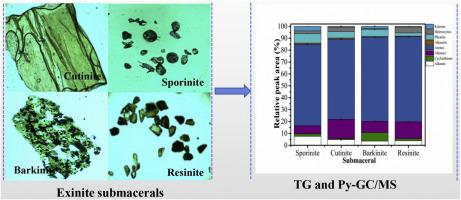当前位置:
X-MOL 学术
›
J. Anal. Appl. Pyrol.
›
论文详情
Our official English website, www.x-mol.net, welcomes your feedback! (Note: you will need to create a separate account there.)
Pyrolysis Behavior and Product Distribution of Exinite Submacerals
Journal of Analytical and Applied Pyrolysis ( IF 6 ) Pub Date : 2020-11-01 , DOI: 10.1016/j.jaap.2020.104957 Lei Liu , Meili Du , Gang Li , Jinwen Fan , Yuchu Cai
Journal of Analytical and Applied Pyrolysis ( IF 6 ) Pub Date : 2020-11-01 , DOI: 10.1016/j.jaap.2020.104957 Lei Liu , Meili Du , Gang Li , Jinwen Fan , Yuchu Cai

|
Abstract This paper systematically investigated the pyrolysis behavior and product distributions of exinite submacerals isolated from different low-rank coal using thermogravimetric analyzer coupled with Fourier Transform infrared spectroscopy (TG-FTIR) and Pyrolyzer coupled with gas chromatography/mass spectrometry (Py-GC/MS). The functional groups in exinite submacerals were studied by FTIR simultaneously. Results suggested that all submacerals were less aromatic with abundant aliphatic chains and more oxygen-containing functional groups. Besides, the TG profiles lateral shifted towards higher temperatures with the heating rates. The kinetic parameters (E and A) indicated that the calculated activation energy and frequency factor of the resinite were the largest, and the barkinite was close to cutinite, while the sporinite was the smallest. The release of CO2, CH4, H2O and CO were measured during pyrolysis process. The temperature intervals and contents for these volatile species reflected the difference in pyrolysis mechanism and the contents of functional groups for different submaceral. According to the fast pyrolysis (650 ℃) by Py-GC/MS, the volatile species could be classified into eight categories including alkanes, alkenes, cycloalkanes, arenes, alcohols, phenols, heteroatomic compounds and ketones. The pyrolysis behavior and product distributions of submacerals were closely related to the chemical structure of its special parent material. The sensitivity of different chemical structures in exinite submacerals to temperature achieved different trends of pyrolysis behavior and product distribution.
中文翻译:

Exinite Submacerals的热解行为和产物分布
摘要 本文利用热重分析仪结合傅里叶变换红外光谱 (TG-FTIR) 和热解仪结合气相色谱/质谱联用 (Py-GC/MS )。同时通过FTIR研究了exinite submacerals中的官能团。结果表明,所有亚基质都具有较少的芳香性,具有丰富的脂肪链和更多的含氧官能团。此外,随着加热速率的增加,TG 分布向更高的温度侧移。动力学参数(E和A)表明树脂岩的计算活化能和频率因子最大,且树皮岩接近于角质岩,而孢子岩最小。在热解过程中测量了 CO2、CH4、H2O 和 CO 的释放。这些挥发性物质的温度区间和含量反映了热解机制的差异和不同亚基质的官能团含量。根据 Py-GC/MS 的快速热解(650 ℃),挥发性物质可分为烷烃、烯烃、环烷烃、芳烃、醇类、酚类、杂原子化合物和酮类 8 类。亚基质的热解行为和产物分布与其特殊母体的化学结构密切相关。Exinite submacerals 中不同化学结构对温度的敏感性实现了不同的热解行为和产物分布趋势。这些挥发性物质的温度区间和含量反映了热解机制的差异和不同亚基质的官能团含量。根据 Py-GC/MS 的快速热解(650 ℃),挥发性物质可分为烷烃、烯烃、环烷烃、芳烃、醇类、酚类、杂原子化合物和酮类 8 类。亚基质的热解行为和产物分布与其特殊母体的化学结构密切相关。Exinite submacerals 中不同化学结构对温度的敏感性实现了不同的热解行为和产物分布趋势。这些挥发性物质的温度区间和含量反映了热解机制的差异和不同亚基质的官能团含量。根据 Py-GC/MS 的快速热解(650 ℃),挥发性物质可分为烷烃、烯烃、环烷烃、芳烃、醇类、酚类、杂原子化合物和酮类 8 类。亚基质的热解行为和产物分布与其特殊母体的化学结构密切相关。Exinite submacerals 中不同化学结构对温度的敏感性实现了不同的热解行为和产物分布趋势。
更新日期:2020-11-01
中文翻译:

Exinite Submacerals的热解行为和产物分布
摘要 本文利用热重分析仪结合傅里叶变换红外光谱 (TG-FTIR) 和热解仪结合气相色谱/质谱联用 (Py-GC/MS )。同时通过FTIR研究了exinite submacerals中的官能团。结果表明,所有亚基质都具有较少的芳香性,具有丰富的脂肪链和更多的含氧官能团。此外,随着加热速率的增加,TG 分布向更高的温度侧移。动力学参数(E和A)表明树脂岩的计算活化能和频率因子最大,且树皮岩接近于角质岩,而孢子岩最小。在热解过程中测量了 CO2、CH4、H2O 和 CO 的释放。这些挥发性物质的温度区间和含量反映了热解机制的差异和不同亚基质的官能团含量。根据 Py-GC/MS 的快速热解(650 ℃),挥发性物质可分为烷烃、烯烃、环烷烃、芳烃、醇类、酚类、杂原子化合物和酮类 8 类。亚基质的热解行为和产物分布与其特殊母体的化学结构密切相关。Exinite submacerals 中不同化学结构对温度的敏感性实现了不同的热解行为和产物分布趋势。这些挥发性物质的温度区间和含量反映了热解机制的差异和不同亚基质的官能团含量。根据 Py-GC/MS 的快速热解(650 ℃),挥发性物质可分为烷烃、烯烃、环烷烃、芳烃、醇类、酚类、杂原子化合物和酮类 8 类。亚基质的热解行为和产物分布与其特殊母体的化学结构密切相关。Exinite submacerals 中不同化学结构对温度的敏感性实现了不同的热解行为和产物分布趋势。这些挥发性物质的温度区间和含量反映了热解机制的差异和不同亚基质的官能团含量。根据 Py-GC/MS 的快速热解(650 ℃),挥发性物质可分为烷烃、烯烃、环烷烃、芳烃、醇类、酚类、杂原子化合物和酮类 8 类。亚基质的热解行为和产物分布与其特殊母体的化学结构密切相关。Exinite submacerals 中不同化学结构对温度的敏感性实现了不同的热解行为和产物分布趋势。



























 京公网安备 11010802027423号
京公网安备 11010802027423号